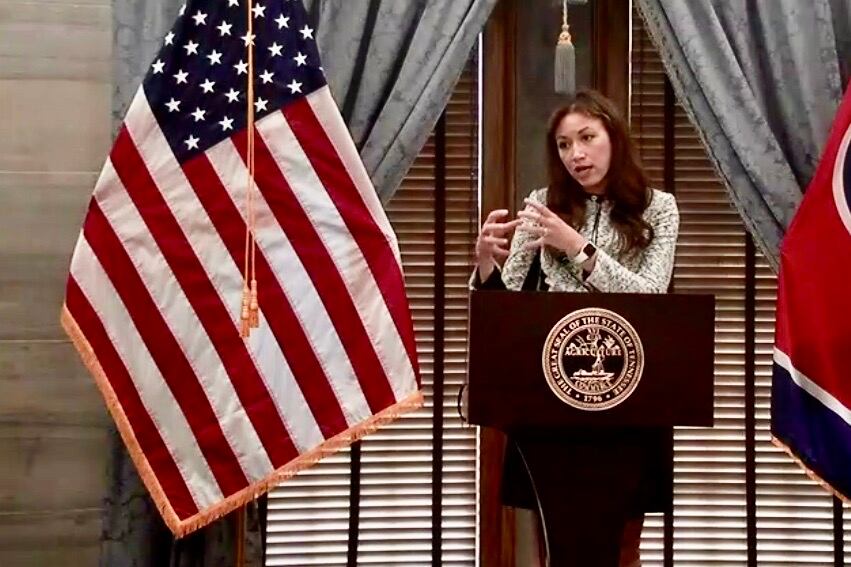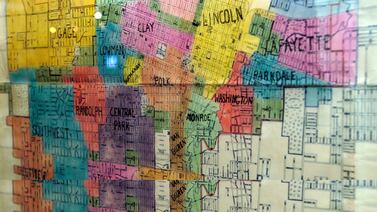Education Commissioner Penny Schwinn estimated Wednesday that Tennessee’s proficiency rates will drop by 50% for third grade reading and even more for math because of schooling disruptions caused by the coronavirus pandemic.
The learning loss, she said, is expected to be especially hard on younger students and disproportionately affect vulnerable populations, such as students of color, those from low-income families, and children with disabilities.
Schwinn and Gov. Bill Lee said the projections should “sound the alarm” about the potential long-term impact of the coronavirus on children. Speaking during the governor’s weekly news conference on COVID-19, they made their case for getting students back into school buildings as soon as possible during the public health crisis.
State officials estimate that about half of Tennessee’s 1 million public school students are learning remotely this fall, with the largest districts in Memphis and Nashville operating 100% virtually. The governor has been adamant that school systems should provide both in-person and online learning options and that learning happens best inside of a brick-and-mortar classroom.
However, several educators told Chalkbeat they have questions about the data used to formulate the projections, as well as the administration’s emphasis on getting kids back in classrooms instead of empowering district leaders and parents to make those decisions based on local community spread of the virus.
“My biggest question is, where did this data come from? What districts provided it?” asked Joey Hassell, superintendent of schools in Haywood County, near Memphis. “We have not provided any data and, as far as I know, the state has not asked for it.”
In Memphis, the state’s largest district, Shelby County Schools, began testing students this week to see how much knowledge they retained since last school year. Those results are expected in mid-October.
Schwinn said the state’s estimates for learning loss are based in part on a study the Tennessee Department of Education conducted in June in partnership with the Center for Research on Education Outcomes, also known as CREDO, and the education nonprofit NWEA. She also cited early diagnostic testing data voluntarily provided by some school districts, as well as the results of an optional state assessment that more than 30,000 students statewide reportedly took at the beginning of the academic year.
“That’s given us a relatively good landscape, or at least a prediction of what that will look like statewide,” Schwinn said.
Asked for details about the data and which districts contributed, a spokeswoman for the department could not immediately provide that information.
The state’s projections were shared one day after several school superintendents told state lawmakers that the gap in learning between high- and low-performing students has widened this year. One superintendent, Linda Cash of Bradley County Schools, said early testing showed that her district’s lowest-performing students had fallen behind up to another two years.
Schwinn said data collected by the state shows that learning loss is affecting students consistently across Tennessee, whether they live in urban, suburban, or rural communities. She was especially concerned about students learning to read in a state where only a third of its third graders have been reading on grade level.
“It is really hard to teach a child to read, but it is really hard to teach a child to read through a computer,” she said.
She and her boss said the state must act quickly to support student learning during the pandemic, but offered no immediate ideas.
“We’ve just gotten this data,” Lee said about the state’s next steps. “We have a real urgency to address it, and we’ll be doing it in the weeks ahead.”
State officials have not yet named members of a special commission that the legislature created in June to examine the educational challenges caused by the pandemic, including learning recovery. That panel is supposed to report its findings to lawmakers by Jan. 1.
Following the press conference, U.S. Sen. Lamar Alexander praised the governor’s focus on getting more students back into classrooms.
“The message is clear,” said the Tennessee Republican, “that children, especially young children who are further behind already, need to be in school so they can be taught in-person so their learning loss is less dramatic.”
Hassell, who leads Haywood County Schools, said no one is arguing that point.
“I don’t know a superintendent who doesn’t think it’s wise for kids to return to school in person,” he said. “But those decisions during this unprecedented time have to be based on local context.”








